Effects of Marking Automated Vehicles on Human Drivers on Highways
Abstract
:1. Introduction
2. Objectives
3. Method
3.1. Preliminary Study: Interview with Driving Instructors
3.2. Procedure
3.3. Apparatus
3.4. Independent Variables
3.4.1. Scenarios
Roadworks
Traffic Jam
Lane Change
3.4.2. Marking the AV
3.5. Dependent Variables
3.5.1. Subjective Data
3.5.2. Objective Data
3.6. Participants
3.7. Analysis
4. Results
4.1. Subjective Data
4.2. Objective Data
5. Discussion
6. Conclusions
Author Contributions
Funding
Acknowledgments
Conflicts of Interest
References
- BMW Group. BMW Group’s Driver Assistance and Autonomous Driving Development Department under New Leadership. Alejandro Vukotich Takes Over at the Helm, Elmar Frickenstein to Retire after Handover Phase. Available online: https://www.press.bmwgroup.com/africa-dom-easteurope/article/detail/T0288264EN/bmw-group%E2%80%99s-driver-assistance-and-autonomous-driving-development-department-under-new-leadership-alejandro-vukotich-takes-over-at-the-helm-elmar-frickenstein-to-retire-after-handover-phase?language=en (accessed on 3 May 2019).
- SAE International. Taxonomy and Definitions for Terms Related to Driving Automation Systems for On-Road Motor Vehicles (J3016); SAE International: Warrendale, PA, USA, 2018. [Google Scholar]
- Schmidt, H.; Terwilliger, J.; AlAdawy, D.; Fridman, L. Hacking Nonverbal Communication between Pedestrians and Vehicles in Virtual Reality. arXiv 2019, arXiv:1904.01931. [Google Scholar]
- Färber, B. Communication and Communication Problems between Autonomous Vehicles and Human Drivers. In Autonomous Driving; Springer: Berlin/Heidelberg, Germany, 2016; pp. 125–144. [Google Scholar]
- Federal Ministry of Justice and Consumer Protection. Durchführungsverordnung zum Fahrlehrergesetz. Available online: https://www.gesetze-im-internet.de/fahrlg2018dv/BJNR000210018.html (accessed on 27 May 2020). (In German)
- Federal Ministry for Digital and Economic Affairs. L17—Ausstattung des Ausbildungsfahrzeugs. Available online: https://www.oesterreich.gv.at/themen/dokumente_und_recht/fuehrerschein/1/2/Seite.040112.html (accessed on 16 January 2020). (In German)
- NZ Transport Agency. Conditions of a Learner Licence. Available online: https://www.nzta.govt.nz/driver-licences/getting-a-licence/licences-by-vehicle-type/cars/learners-licence/conditions-of-a-learner-licence/ (accessed on 28 January 2020).
- Kühn, M.; Stange, V.; Vollrath, M. Menschliche Reaktion auf hochautomatisierte Fahrzeuge im Mischverkehr auf der Autobahn. In VDI Tagung Mensch-Maschine-Mobilität 2019—Der (Mit-) Fahrer im 21. Jahrhundert!? VDI Verlag: Düsseldorf, Germany, 2019; pp. 169–184. (In German) [Google Scholar]
- Joisten, P.; Alexandi, E.; Drews, R.; Klassen, L.; Petersohn, P.; Pick, A.; Schwindt, S.; Abendroth, B. Displaying Vehicle Driving Mode—Effects on Pedestrian Behavior and Perceived Safety. In Human Systems Engineering and Design II; Ahram, T., Karwowski, W., Pickl, S., Taiar, R., Eds.; Springer International Publishing: Cham, Switzerland, 2020; pp. 250–256. ISBN 978-3-030-27927-1. [Google Scholar]
- Rodríguez Palmeiro, A. Interaction between pedestrians and Wizard of Oz automated vehicles. Master’s Thesis, Delft University of Technology, Delft, The Netherlands, 2017. [Google Scholar]
- Faas, S.M.; Mathis, L.-A.; Baumann, M. External HMI for self-driving vehicles: Which information shall be displayed? Transp. Res. Part F Traffic Psychol. Behav. 2020, 68, 171–186. [Google Scholar] [CrossRef]
- Bengler, K.; Rettenmaier, M.; Fritz, N.; Feierle, A. From HMI to HMIs: Towards an HMI Framework for Automated Driving. Information 2020, 11, 61. [Google Scholar] [CrossRef] [Green Version]
- Weber, F.; Chadowitz, R.; Schmidt, K.; Messerschmidt, J.; Fuest, T. Crossing the Street across the Globe: A Study on the Effects of eHMI on Pedestrians in the US, Germany and China. In Human-Computer Interaction in Mobility, Transport, and Automotive Systems; Krömker, H., Ed.; Springer International Publishing: Cham, Switzerland, 2019; pp. 515–530. ISBN 978-3-030-22665-7. [Google Scholar]
- Hensch, A.-C.; Neumann, I.; Beggiato, M.; Halama, J.; Krems, J.F. How Should Automated Vehicles Communicate?—Effects of a Light-Based Communication Approach in a Wizard-of-Oz Study. In Advances in Human Factors of Transportation; Stanton, N., Ed.; Springer International Publishing: Cham, Switzerland, 2020; pp. 79–91. ISBN 978-3-030-20502-7. [Google Scholar]
- Song, Y.E.; Lehsing, C.; Fuest, T.; Bengler, K. External HMIs and Their Effect on the Interaction between Pedestrians and Automated Vehicles. In Intelligent Human Systems Integration; Karwowski, W., Ahram, T., Eds.; Springer International Publishing: Cham, Switzerland, 2018; pp. 13–18. ISBN 978-3-319-73887-1. [Google Scholar]
- Rettenmaier, M.; Pietsch, M.; Schmidtler, J.; Bengler, K. Passing through the Bottleneck—The Potential of External Human-Machine Interfaces. In Proceedings of the 2019 IEEE Intelligent Vehicles Symposium (IV), Paris, France, 9–12 June 2019; pp. 1687–1692, ISBN 978-1-7281-0560-4. [Google Scholar]
- De Clercq, K.; Dietrich, A.; Velasco, J.P.N.; De Winter, J.C.F.; Happee, R. External Human-Machine Interfaces on Automated Vehicles: Effects on Pedestrian Crossing Decisions. Hum. Factors 2019, 61, 1353–1370. [Google Scholar] [CrossRef] [PubMed] [Green Version]
- Dietrich, A.; Willrodt, J.-H.; Wagner, K.; Bengler, K. Projection-Based External Human Machine Interfaces–Enabling Interaction between Automated Vehicles and Pedestrians. In Proceedings of the DSC Europe 2018 VR. Driving Simulation & Virtual Reality Conference & Exhibition, Antibe, France, 5–7 September 2018; pp. 43–50, ISBN 978-2-85782-734-4. [Google Scholar]
- Rettenmaier, M.; Albers, D.; Bengler, K. After you?!—Use of external human-machine interfaces in road bottleneck scenarios. Transp. Res. Part F Traffic Psychol. Behav. 2020, 70, 175–190. [Google Scholar] [CrossRef]
- Werner, A. New Colours for Autonomous Driving: An Evaluation of Chromaticities for the External Lighting Equipment of Autonomous Vehicles. Colour Turn 2019. [Google Scholar] [CrossRef]
- SAE International. Automated Driving System (ADS) Marker Lamp; SAE International: Warrendale, PA, USA, 2019. [Google Scholar]
- Böckle, M.-P.; Brenden, A.P.; Klingegård, M.; Habibovic, A.; Bout, M. SAV2P—Exploring the Impact of an Interface for Shared Automated Vehicles on Pedestrians’ Experience. In Proceedings of the 9th International Conference on Automotive User Interfaces and Interactive Vehicular Applications Adjunct (Automotive UI ’17), Oldenburg, Germany, 24–27 September 2017; Löcken, A., Boll, S., Politis, I., Osswald, S., Schroeter, R., Large, D., Baumann, M., Alvarez, I., Chuang, L., Feuerstack, S., et al., Eds.; ACM Press: New York, NY, USA, 2017; pp. 136–140, ISBN 9781450351515. [Google Scholar]
- Eisma, Y.; Van Bergen, S.; Ter Brake, S.; Hensen, M.; Tempelaar, W.; De Winter, J.C.F. External human—Machine interfaces: The effect of display location on crossing intentions and eye movements. Information 2019, 11, 13. [Google Scholar] [CrossRef] [Green Version]
- Clamann, M.; Aubert, M.; Cummings, M.L. Evaluation of Vehicle-to-Pedestrian Communication Displays for Autonomous Vehicles. In Proceedings of the 96th Annual Transportation Research Board Meeting, Washington, DC, USA, 8–12 January 2017. [Google Scholar]
- Fuest, T.; Michalowski, L.; Traris, L.; Bellem, H.; Bengler, K. Using the Driving Behavior of an Automated Vehicle to Communicate Intentions—A Wizard of Oz Study. In Proceedings of the 2018 21st International Conference on Intelligent Transportation Systems (ITSC), Maui, HI, USA, 4–7 November 2018; pp. 3596–3601. [Google Scholar] [CrossRef]
- Fuest, T.; Maier, A.S.; Bellem, H.; Bengler, K. How Should an Automated Vehicle Communicate Its Intention to a Pedestrian?—A Virtual Reality Study. In Human Systems Engineering and Design II; Ahram, T., Karwowski, W., Pickl, S., Taiar, R., Eds.; Springer International Publishing: Cham, Switzerland, 2020; pp. 195–201. [Google Scholar] [CrossRef]
- Fuest, T.; Michalowski, L.; Schmidt, E.; Bengler, K. Reproducibility of Driving Profiles—Application of the Wizard of Oz Method for Vehicle Pedestrian Interaction. In Proceedings of the 2019 IEEE Intelligent Transportation Systems Conference (ITSC), Auckland, New Zealand, 27–30 October 2019; pp. 3954–3959. [Google Scholar] [CrossRef]
- Fuest, T.; Sorokin, L.; Bellem, H.; Bengler, K. Taxonomy of Traffic Situations for the Interaction between Automated Vehicles and Human Road Users. In Advances in Human Aspects of Transportation. AHFE 2017. Advances in Intelligent Systems and Computing; Stanton, N.A., Ed.; Springer International Publishing: Cham, Switzerland, 2018; Volume 597, pp. 708–719. [Google Scholar] [CrossRef]
- Würzburg Institute for Traffic Sciences GmbH. Driving Simulation and SILAB. Available online: https://wivw.de/en/silab (accessed on 14 April 2020).
- Technical University of Munich. Static Driving Simulator. Available online: https://www.mw.tum.de/en/lfe/research/labs/static-driving-simulator/ (accessed on 14 April 2020).
- Surges, F. Einfluss Hochautomatisiert Fahrender Fahrzeuge auf das Fahrverhalten und Die Einstellungen Manueller Fahrer im Mischverkehr; BASt (Bundesanstalt für Strassenwesen (Federal highway research institute))-Project: F1100.4318007. Available online: https://trid.trb.org/view/1576671 (accessed on 27 May 2020). (In German).
- Wachenfeld, W.; Winner, H. Do Autonomous Vehicles Learn. In Autonomous Driving; Maurer, M., Gerdes, J.C., Lenz, B., Winner, H., Eds.; Springer: Berlin/Heidelberg, Germany, 2016; pp. 451–471. [Google Scholar]


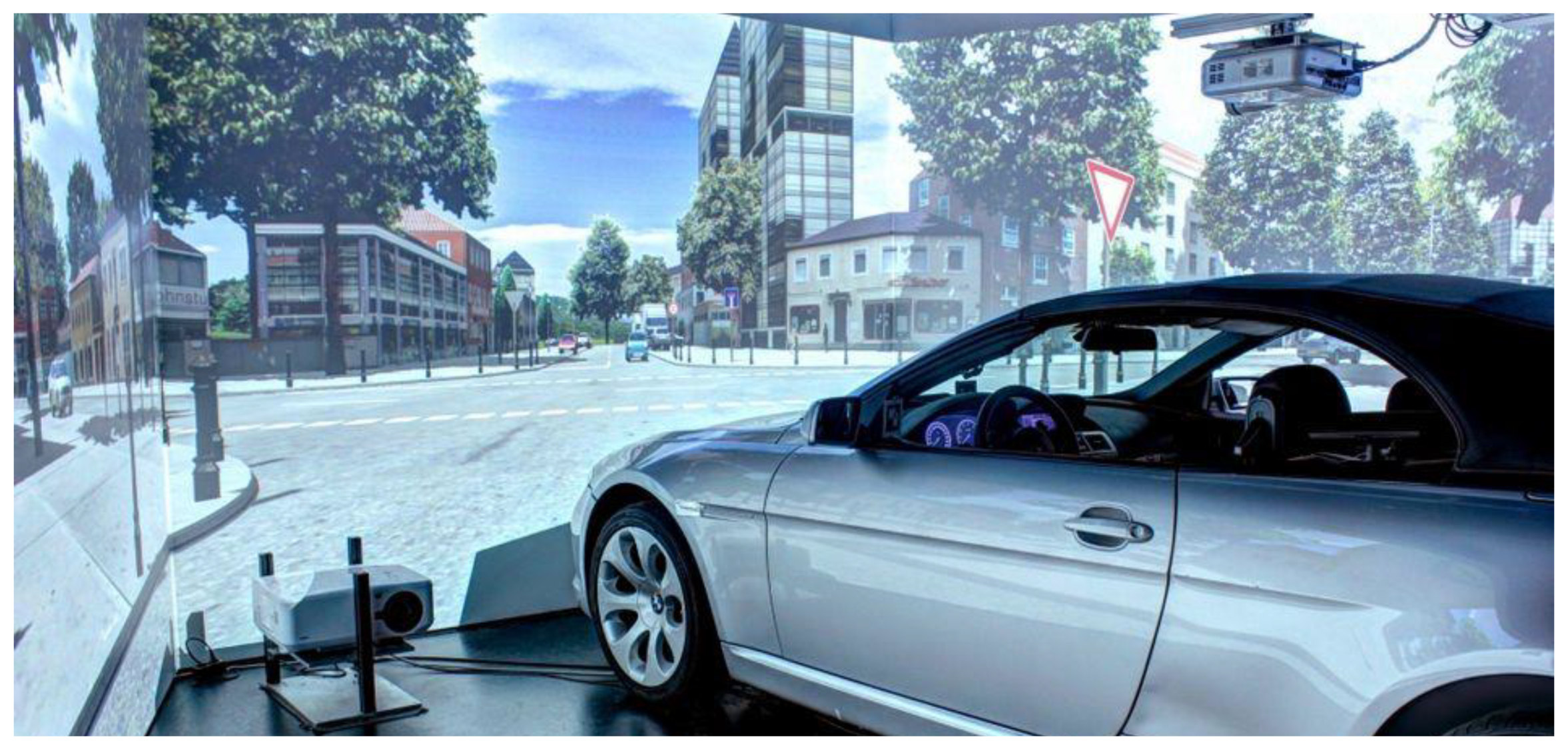


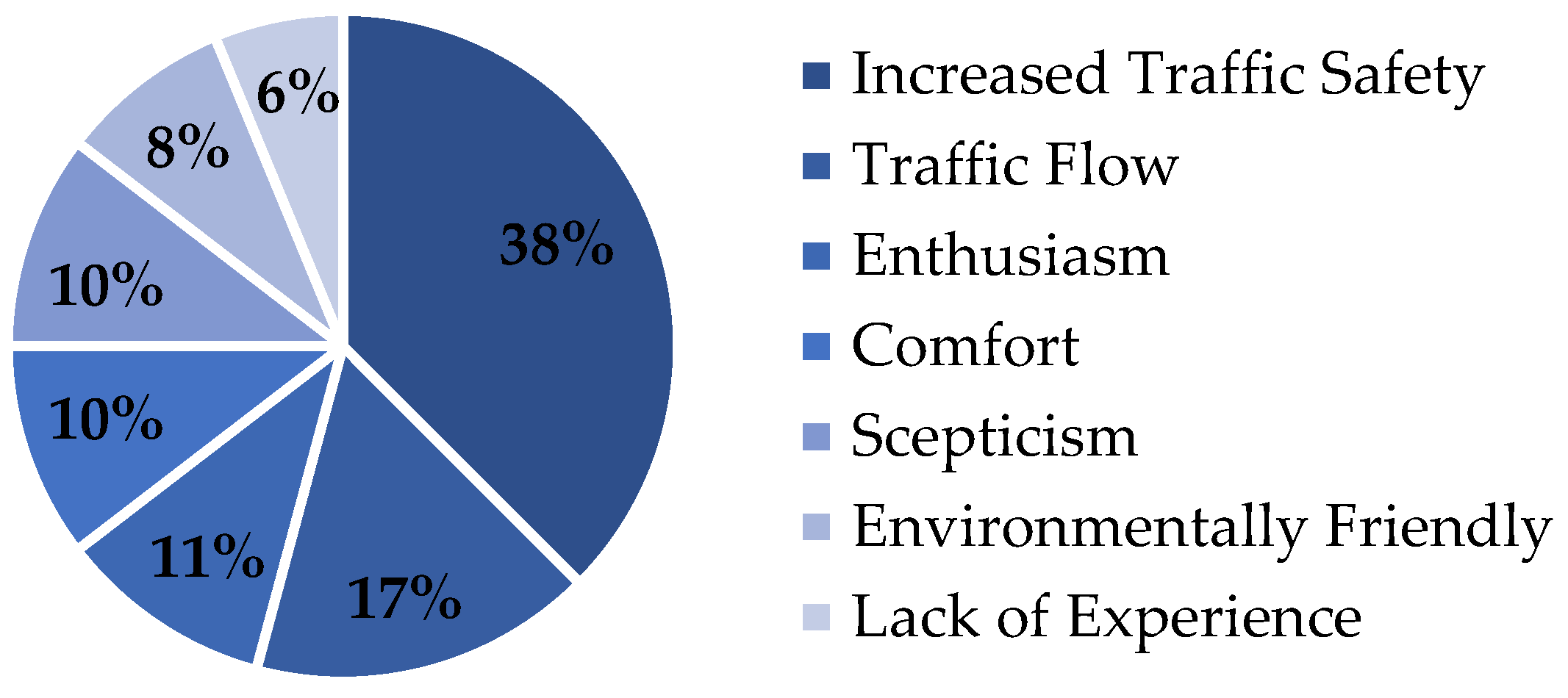
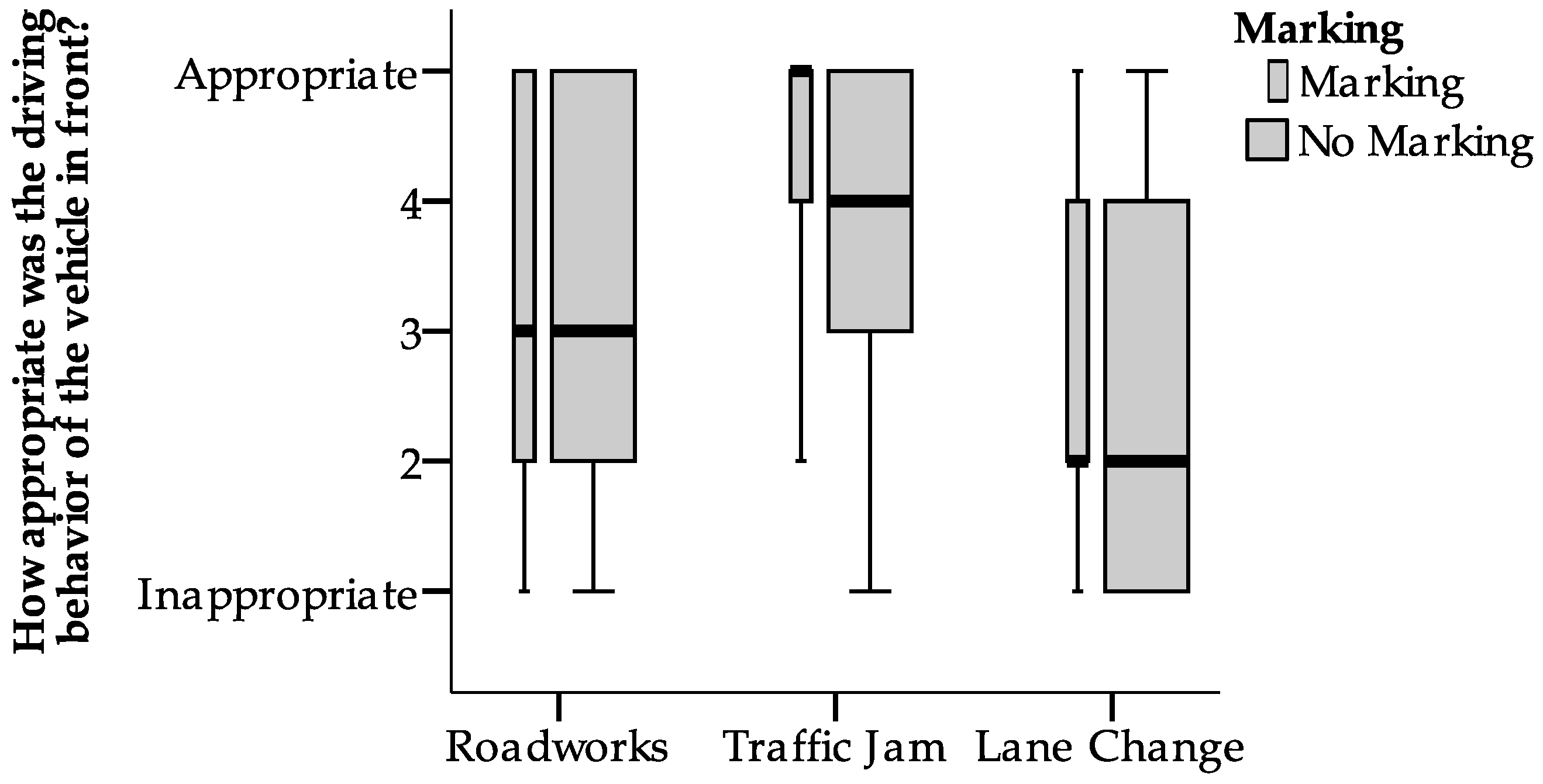

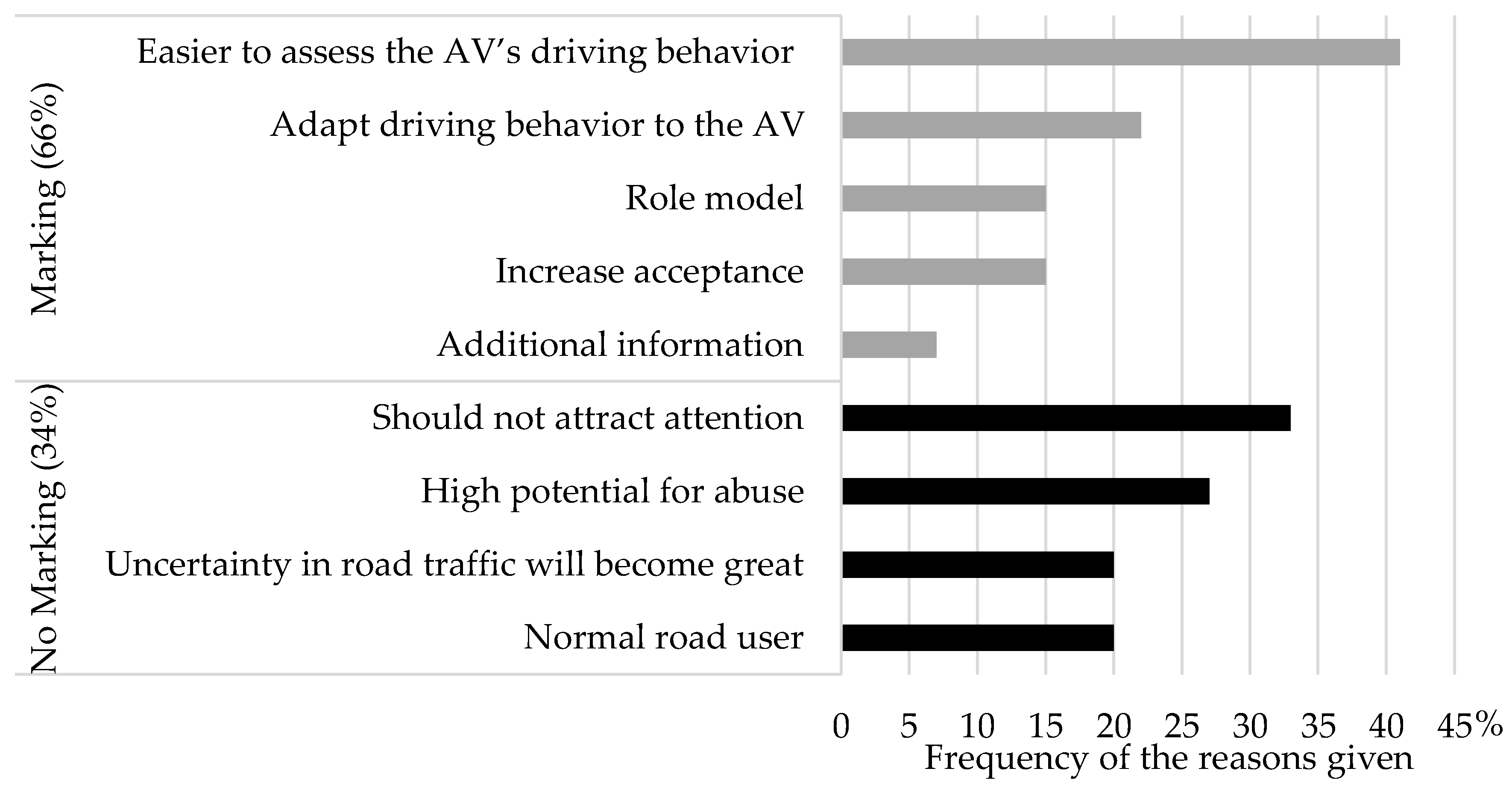
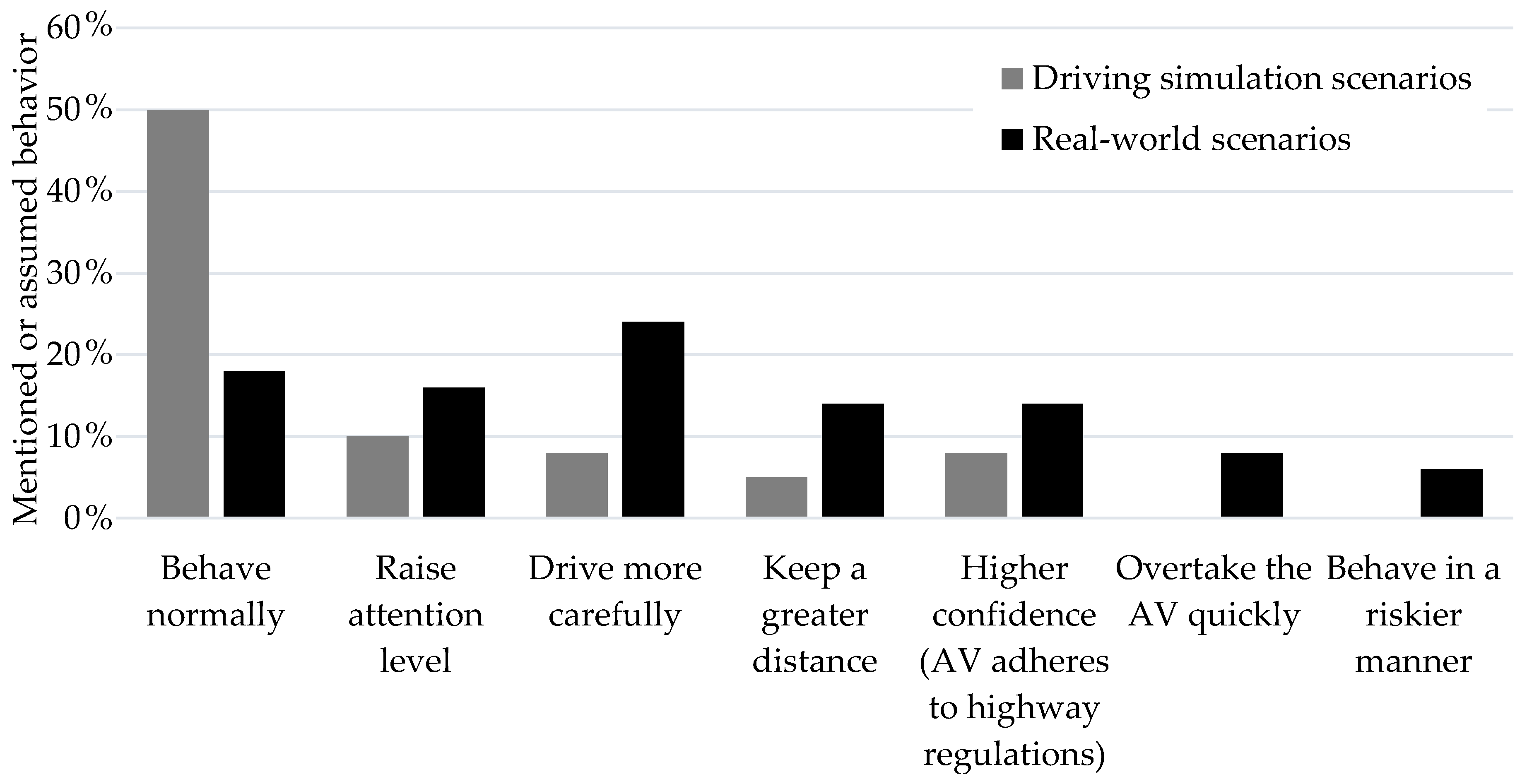

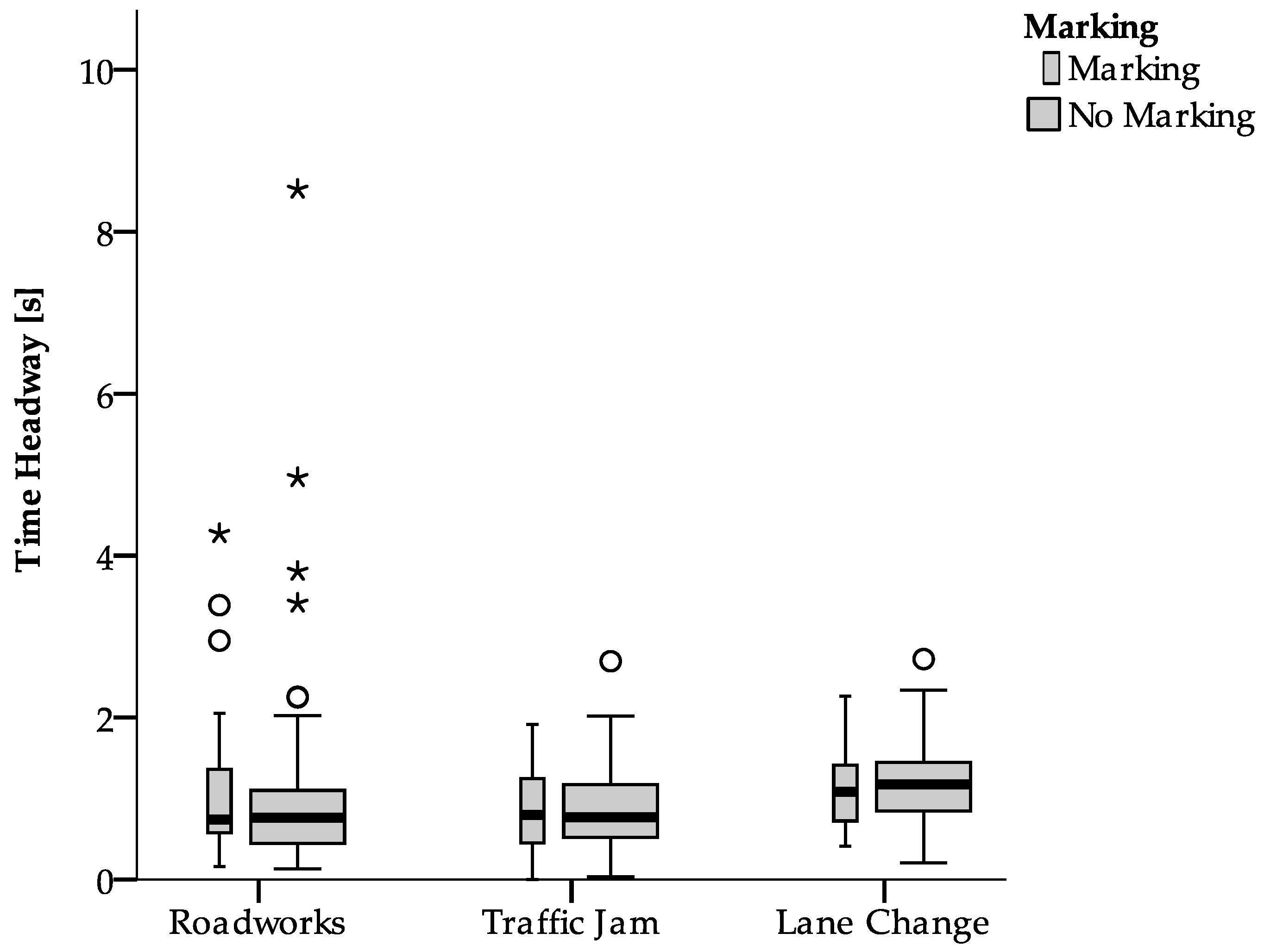
| Roadworks | Traffic Jam | Lane Change | ||||
|---|---|---|---|---|---|---|
| Marking | No Marking | Marking | No Marking | Marking | No Marking | |
| Behavior as Expected | 45.9% | 50.0% | 80.6% | 69.2% | 31.6% | 21.1% |
| Behavior not as Expected | 54.1% | 50.0% | 19.4% | 30.8% | 68.4% | 78.9% |
| Roadworks | Traffic Jam | Lane Change | |
|---|---|---|---|
| Marking | 27 (73.0%) | 14 (48.3%) | 16 (44.4%) |
| No Marking | 24 (63.2%) | 15 (55.6%) | 15 (41.7%) |
© 2020 by the authors. Licensee MDPI, Basel, Switzerland. This article is an open access article distributed under the terms and conditions of the Creative Commons Attribution (CC BY) license (http://creativecommons.org/licenses/by/4.0/).
Share and Cite
Fuest, T.; Feierle, A.; Schmidt, E.; Bengler, K. Effects of Marking Automated Vehicles on Human Drivers on Highways. Information 2020, 11, 286. https://doi.org/10.3390/info11060286
Fuest T, Feierle A, Schmidt E, Bengler K. Effects of Marking Automated Vehicles on Human Drivers on Highways. Information. 2020; 11(6):286. https://doi.org/10.3390/info11060286
Chicago/Turabian StyleFuest, Tanja, Alexander Feierle, Elisabeth Schmidt, and Klaus Bengler. 2020. "Effects of Marking Automated Vehicles on Human Drivers on Highways" Information 11, no. 6: 286. https://doi.org/10.3390/info11060286





